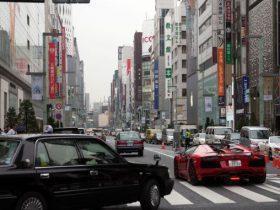By Audrey Henderson
A new congestion pricing policy that begins in Chicago this month is aimed not only at reducing traffic but also moving toward a more equitable, and lower-carbon, transportation system.
In her first State of the City address in August 2019, Chicago Mayor Lori Lightfoot said she was “exploring revenue options to address rampant congestion that solves the problems of traffic, pollution and other issues.” New fees imposed on ride-hailing services, such as Uber and Lyft, are a part of that strategy.
The new fee structure, which began on Jan. 6, increases fees for trips in the downtown core while lowering rates for shared rides elsewhere in the city and for wheelchair users. Revenues from the fees are projected at $40 million, with $2 million going toward transit projects.
The new fees are based on findings in an October 2019 study produced by the city. The study found that between 2015 and 2018, the number of trips by ride-hailing services more than tripled, with half of rides either beginning or ending downtown, and nearly one-third of rides taking place entirely within the downtown area. The report also found that ride-hailing services had adversely affected transit ridership.
While Chicago’s new fees differ from a London-type congestion pricing scheme — in which drivers must pay a daily fee to drive within a designated charge zone — they do fall under the broad umbrella of congestion pricing, according to Audrey Wennink, transportation director for the Metropolitan Planning Council. Other options include managed lanes, which employ tolls or other restrictions on a specific lane of a road to control the flow of traffic. Parking can also be considered congestion pricing, she added, “depending on how it’s done.”
“It’s kind of like a suite of tools,” she said. “It doesn’t mean one thing.”
Both Lyft and Uber strongly opposed the fees. Each service issued statements claiming that the fees would have a disproportionate effect on low-income residents on the city’s South and West Sides. In its statement, Lyft claimed that the new fees “reduce affordability and reliability while doing nothing to improve mobility.” Uber was even more explicit, stating that the new fees “will take money out of the pockets of riders, who rely on apps to get around, and of drivers — half of whom live in the south and west sides of the city” and “who do not contribute to congestion and lack reliable access to transportation.”
A coalition called Moving Illinois Forward published results of a survey in September 2019 urging a repeal of the new fees. The survey claimed that for a majority of Chicagoans, particularly among the African American and Latinx communities, ride-hailing filled a gap in service created by taxicab drivers who discriminate against riders of color.
However, this claim has been widely disputed. The Center for Neighborhood Technology found that the new fees were more equitable than the previous flat fee structure. Under the new varied fee structure, the cost of trips between neighborhoods would actually decrease.
Lightfoot also received support from a group of transportation and sustainability organizations including the Metropolitan Planning Council, the Center for Neighborhood Technology, the Active Transportation Alliance, the Chicago Council on Global Affairs, the Shared-Use Mobility Center, the University of Illinois at Chicago Department of Urban Planning and Policy, and the Chaddick Institute for Metropolitan Development at DePaul University. Ride-hailing service Via was also a signatory to an open letter addressed to the mayor.
A legacy of segregation
The South and West Sides of Chicago are geographically larger, yet more sparsely populated than the North Side. These neighborhoods are primarily populated by low-income residents and people of color. There is also less access to public transit, especially rail transit, than in the city’s North Side, which is predominantly white and more affluent.
For example, the Chicago Transit Authority (CTA) rail system extends north past the city limits through Evanston to Wilmette, and as far west as Forest Park and Oak Park, both western suburbs. By contrast, the system only extends as far south as 95th Street, miles short of the city limit, which borders with Indiana.
As a result, many residents on the city’s South Side and West Side primarily rely either on buses or cars — including rideshare — to get around. But approximately $2 million of the $40 million projected to be raised by the new fees will be devoted to expanding transit in the region, through projects like the bus priority zone and the proposed Gray Line.
The Bus Priority Zone Program, a joint project by the transit agency and the Chicago Department of Transportation, is designed to relieve congestion and improve service on seven bus lines throughout the city. The first project of the program is the introduction of two bus-only lanes, improved signage and other enhancements along 79th Street — served by one of the highest bus ridership routes in the city.
The Gray Line has been promoted since 1996 by transit advocate Mike Payne. The Gray Line would introduce CTA pricing and service frequency to the existing Metra Electric line, a commuter rail service that runs from downtown Chicago southward.
In recent years, the idea of coordinating Metra and CTA service to provide a service like the Gray Line has gained traction. A coalition of nonprofit and business groups support the idea. Cook County Board President Toni Preckwinkle recently backed a pilot program to introduce lower fares and expanded service on the Metra Electric and Rock Island lines that service the city’s South Side and in the southern suburbs. Lightfoot has expressed reservations about the plan, claiming it would adversely affect CTA ridership. However, the mayor’s office reports that discussions are ongoing.
Thoughtful implementation of congestion pricing, along with devoting at least a portion of revenues raised to enhance transit programs like the bus priority zone and the Gray Line could conceivably create an equitable congestion pricing system in Chicago, according to Wennink.
“The overall goal for all of transportation should be having the most sustainable modes of transportation be attractive choices and work well for people,” she said. “And that’s transit, biking and walking. It’s environmentally sustainable. It’s good for the region, and it’s good for everyone. But you have to make it attractive. You have to make it worthwhile for people. You have to make it available. You have to make the fares reasonable. Policies that we’ve had have favored cars and favored roads, and we need to work in the other direction.”















